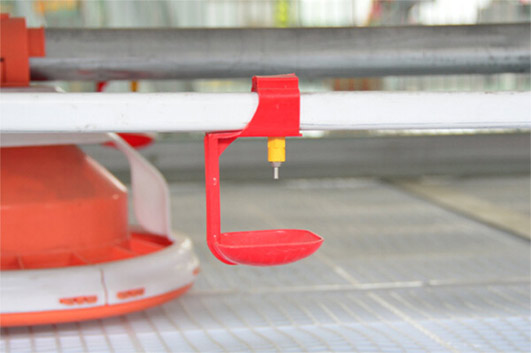How to raise and manage broiler chickens in broiler cages?
- font size
- Be the first to comment!
This year's broiler farming industry has a good form due to the continued high pork growth. Many people want to raise broilers and don't know how to manage them. Next, the author will briefly introduce the management techniques of using broiler battery cages system to raise broilers.
1. Preparation before the chicken
1.1 Check the waterline
Ensure that each hose is in good condition, no water leakage, no water seepage, and ensure normal water supply.
1.2 inspection cage
Make sure that each nipple is switched freely and that each cage is closed. In case the chicken is drilled out of the cage.
1.3 test temperature
Check whether the water pipeline, boiler, temperature control computer and radiator are normal. Place the temperature control probe on the horizontal level of the second layer chicken. Then close all vents and skylights and ignite the heat. Observe the time required for the room temperature to reach 30 °C. At the same time, according to the indoor structure and layout of the chicken shed, place the hygrometer and thermometer in different parts such as upper, middle and lower layers. Check the actual humidity and temperature of each part, see how big the gap is with the temperature control computer, and make a record.

1.4 check the light
The light in the room should be soft and bright, and it can pass through various parts to ensure sufficient light.
1.5 Checking the power line
It is necessary to carefully check the electrical lines of each appliance to see if the wiring is leaking, and there are more metal in the chicken house. Leakage can have serious consequences.
1.6 disinfection
Choose a disinfectant that is not corrosive to metals. The chicken house was closed for 1 week in advance for fumigation for 24 to 48 hours. After ventilation for 20 days, spray disinfection.
2. Feeding management
2.1 brooding points
The indoor temperature should be strictly controlled. Before the chicks, the room temperature is about 30 °C, and the room temperature gradually rises to about 33-35 °C after entering the chicks. It is best to raise broilers in the uppermost layer, brooding 27.30 per cage. Fill the cage with the small tray in advance. The water tank is pre-heated in order to pre-warm (consistent with the indoor temperature). After the chickens arrive, quickly place the chicks in the room, place them evenly, and then count the cages. 3 to 5 days before brooding. Drinking water should be added: glucose, astragalus polysaccharides, antibacterial drugs, and electrolysis. The purpose is to restore the chicks' physical strength, relieve stress, kill the vertically-transmitted pathogens, promote the development of immune organs in the chicks, and improve the disease resistance of the chickens.
2.2 feeding management
It is best to feed every morning, and the automatic feeding system machine is better to feed three times a day. When using the trough, the artificial feeding should be added evenly and feed in time. Prevent the chicken from being trampled due to hunger and food. The breeder checks whether there is an empty trough every afternoon and should replenish it in time. The feeding situation of the trough should be checked daily, and more materials should be taken in time to take measures. Analyze and judge the possible situation: there are fewer chickens in the cage, and the staff should be replenished in time; if the nipple is short of water; if there are any sick chickens in the cage, individual treatment or elimination should be picked out in time. Whether the lighting is insufficient, we must take timely measures to make adjustments.
2.3 drinking water management
Water supply should be guaranteed for 24 hours. In addition to medication or seedlings, water should be controlled. Always check the water line for blockages, which is a critical issue for each farm. Early detection is required. The nipple leaks, the water that flows out wastes the drug, and it enters the septic tray, which dilutes the faeces and flows into the trough. One is to waste feed, and the other is to cause intestinal diseases.


